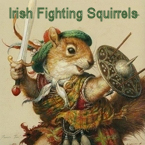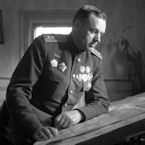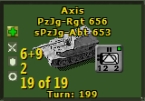Meyer1
Posts: 899
Joined: 2/9/2010
Status: offline

|
quote:
ORIGINAL: Curtis Lemay
I would guess that the figures you're quoting pertained to moving through enemy territory - with the tanks unlimbered. In that circumstance, TOAW imposes hex-conversion costs. At a minimum, those costs will expend half the unit's movement allowance. That's far more than adequate to accommodate the issue you raise.
Actually, the only difference between a march where no enemy contact is expected, and one where there is, is that in the latter an "advance guard" is formed, and in the first case the wheeled vehicles are sent ahead to the next stop instead of travelling alongside the tracked elements.
quote:
The only circumstance where this might still be an issue would be moving behind your own lines, through your pre-converted grid. In those cases, tanks usually moved limbered - lifted on trucks. That allows faster movement with far less breakdown. You are also moving in much greater confidence from enemy attack.
I wouldn't say "usually". The Germans had early in the war in their "Leichte" Divisions, the "Panzer-Abteilung (Verlastet)" with the Pz.I and II transported on trucks, but that was the exception, and this is also dependant on road conditions.
Also, in TOAW, a unit could be moving over recently converted "friendly" hexes, well behind enemy lines. You won't see the tanks over trucks in those cases.
Anyway this is a moot point, because the tanks over trucks-thing is not modeled in the game, so we have to assume that all armoured movement happens over tracks or trains.
Usually, if available, units moved longer distance by rail, if they're moving by wheel/track you could assume that they're relatively close to the front, interested in not being noticed, and since we are in war, subject to air attack. Even without those threats the speed of the column would remain the same, because that's a technical question and not a tactical one.
Anyway , if in the example above, the units have to pay 2mp per hex because of hex conversion, yeah the problem is smaller but not completely solved.
quote:
I wasn't talking about the capacity of the units - but rather the capacity of the road itself. While the units might have to pull over and rest/refit, the road would be in continuous use. That very duty cycle would allow multiple units to use the road as if they were fewer units - especially if they are just sharing an intersection, and then spreading out to different end locations. Furthermore, under emergency conditions, both lanes of the road could be commandeered in the same direction for a bit - doubling capacity.
You can fiddle with the figures a bit, but it still turns out to be a huge number - far greater than normal usage.
Sorry, I disagree completely. There's no way that you would see two units using the same road with one advancing when the other stops. That's a recipe for disaster. I would say that for an "emergency" what changes are the interval between vehicles. But, again, I don't think those "emergency marches" occurred, armies had normal and "forced" marches, the latter with fewer stops.
But, again, since we don't have two march speeds in the game (actually that would be nice) we have to use the most common type.
I don't have a problems with the intersections, other than that's when traffic jams were very likely.
quote:
Sources vary, and they have to be put into context. My source said 322,000 motor vehicles crossed the border in June. Maybe your figures were for the entire campaign? Regardless, most of the vehicles would be in the rear areas, strung out in supply lines. I doubt there were ever even 100,000 front-line vehicles at any one time in Barbarossa.
yeah well, don't worry about that, was just a side note. Not gonna look now for that number, but I have one fresh in my mind for re-reading KH Frieser book of the 1940 campaign (great one BTW), where it says that Gruppe Kleist alone had over 41,000 vehicles. Also great traffic jam story there 
quote:
Let's start with the fact that the units in that case violate the stacking limits for 10km hexes (250 vehicles). A panzer division would probably be modeled with from 400 to 500 front-line vehicles. So, regiments would be more appropriate for this scale. Regiments are going to be incurring stacking penalties if they move through each other - again, adequate for the issue if that occurs.
Yeah, with two divisions in one hex you get the red light here. The thing is, and my whole point, is that if you move one unit at a time you pay no penalty.
quote:
Even without that, three panzer divisions only amount to about 1500 front-line vehicles - easily within the 3 1/2 hour capacity of the road .
More like 4000 total vehicles per division, I don't think we have to make a distinction between front-line and the others, to calculate how clogged a road should be.
quote:
The extreme examples you give are absurd, of course - and would have incurred plenty of stacking penalties regardless.
Yeah is a little extreme but not that rare, f.e. you could see something like that in the highway of AGC in the eastern front scenarios...
< Message edited by Meyer1 -- 9/20/2015 7:47:34 AM >
|
 Printable Version
Printable Version












 , where each road (or hex?) would have a movement capacity that is filled each time a unit uses it, and that would be clear at the finish of each round, such as I think is the case with the BTS.
, where each road (or hex?) would have a movement capacity that is filled each time a unit uses it, and that would be clear at the finish of each round, such as I think is the case with the BTS. 





 New Messages
New Messages No New Messages
No New Messages Hot Topic w/ New Messages
Hot Topic w/ New Messages Hot Topic w/o New Messages
Hot Topic w/o New Messages Locked w/ New Messages
Locked w/ New Messages Locked w/o New Messages
Locked w/o New Messages Post New Thread
Post New Thread